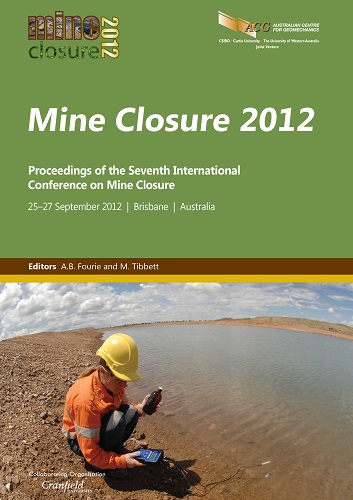Mine closure drainage channel planning – lessons learned

|
Authors: Kammerzell, KC Paper is not available for download Contact Us |
DOI https://doi.org/10.36487/ACG_rep/1208_10_Kammerzell
Cite As:
Kammerzell, KC 2012, 'Mine closure drainage channel planning – lessons learned', in AB Fourie & M Tibbett (eds), Mine Closure 2012: Proceedings of the Seventh International Conference on Mine Closure, Australian Centre for Geomechanics, Perth, pp. 93-99, https://doi.org/10.36487/ACG_rep/1208_10_Kammerzell
Abstract:
Controlling surface water at mine locations using drainage channels for diversion of upland watersheds or distribution/collection of runoff from mine properties is common practice around the globe. During operation, channels are used to limit surface water impacts to active mining efforts using the least amount of work space feasible. In mine closure, channels are used to limit the exposure of cover systems to rainwater infiltration or erosion and are expected to perform for years after the closure has been completed. If not planned or maintained properly, these drainage features can fail at the most inopportune time, causing stoppage of work or compromising a critical facility under closure. This paper presents a management approach to drainage channel planning to incorporate closure configurations into operating drainage control activities. Looks at common failure modes of channels by example and recommends methods to minimise the failure risk in future configurations. The paper also identifies value engineering opportunities to limit both initial capital and long term maintenance requirements for channels. These are accomplished by planning locations of diversion and collection channels that function in tandem under both closure and operating conditions. Controlling how water enters the channel from upland features, limiting the undermining of drainage control features by erosion adjacent to the channel; Designing bedding of riprap lined channels to limit the most common failure modes; and, localising energy drops in long channels to focus highest erosion risk to controlled sections of more robust revetment, limiting cost projected over the structure length.
References:
Bathurst, J.C., Li, R.M. and Simons, D.B. (1979) Hydraulics of Mountain Rivers, Colorado State University Experiment Station, United States of America, 229 p.
Chen, Y.H. and Cotton, G.K. (1988) Design of Roadside Channels with Flexible Linings, Federal Highway Administration Hydraulic Engineering Circular #15, United States of America, 125 p.
Hagerty, D.J. and Parola, A.C. (2001) Seepage Effects in Some Riprap Revetments, Journal of Hydraulic Engineering, July 2001, United States, Vol. 127, No. 7, pp. 556–566.
Holtz, R.D. and Kovacs, W.D. (1981) An Introduction to Geotechnical Engineering, Prentice Hall, Inc., Englewood Cliffs, N.J. 07632.
Mengler, F.C. and Gilkes, R.J. (2006) Thresholds, Triggers and Time – Erosion Risk on Evolving Reclaimed Landforms after Bauxite Mining in the Darling Range, Western Australia, in Proceedings First International Seminar on Mine Closure (Mine Closure 2006), A.B. Fourie and M. Tibbett (eds), 13‒15 September 2006, Perth, Australia, Australian Centre for Geomechanics, Perth, pp. 587–597.
Simons, D.B., Chen, Y.H., Swenson, L.J. and Simons, Li & Associates Inc. (1984) Hydraulic Test to Develop Design Criteria for the use of Reno Matresses, Engineering Research Center, Colorado State University.
Temple, D.M., Robinson, K.M., Ahring, R.M. and Davis, A.G. (1987) Stability Design of Grass-Lined Open Channels, US Department of Agriculture, Agriculture Handbook 667, 175 p.
US Army Corps of Engineers (1994) Hydraulic Design of Flood Control Channels, Engineer Manual 1110-2-1601, 183 p.
© Copyright 2025, Australian Centre for Geomechanics (ACG), The University of Western Australia. All rights reserved.
View copyright/legal information
Please direct any queries or error reports to repository-acg@uwa.edu.au
View copyright/legal information
Please direct any queries or error reports to repository-acg@uwa.edu.au